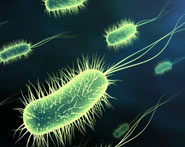


 النبات
النبات
 الحيوان
الحيوان
 الأحياء المجهرية
الأحياء المجهرية
 علم الأمراض
علم الأمراض
 التقانة الإحيائية
التقانة الإحيائية
 التقنية الحيوية المكروبية
التقنية الحيوية المكروبية
 التقنية الحياتية النانوية
التقنية الحياتية النانوية
 علم الأجنة
علم الأجنة
 الأحياء الجزيئي
الأحياء الجزيئي
 علم وظائف الأعضاء
علم وظائف الأعضاء
 الغدد
الغدد
 المضادات الحيوية
المضادات الحيوية|
Read More
Date:
Date: 3-6-2021
Date: 1-12-2015
|
Carboxypeptidases
Enzymes that catalyze the hydrolytic cleavage of the carboxyl-terminal amino acid residue from an oligo- or polypeptide chain are called carboxypeptidases.
One group of these enzymes uses a catalytic mechanism analogous to that of the serine proteinases and, in fact, are inhibited by the prototypical serine proteinase inhibitor, diisopropylfluorophosphate ) DIFP). These enzymes are found in the vacuoles of higher plants and fungi and in the lysosomes of animal cells, and they presumably participate in intracellular protein degradation. Many fungi also secrete serine carboxypeptidases. Carboxypeptidase Y (E.C. 3.4.16.1) is a serine carboxypeptidase present in yeast vacuoles (1). It is a very useful enzyme for determining the amino acid sequence of peptides and proteins, because it can release all C-terminal amino acids, including proline. Moreover, it is active in the presence of denaturants, such as urea or sodium dodecyl sulfate (SDS), and in the pH range from 4 to 7.
The other group contains metallocarboxypeptidases, which have a zinc ion at the catalytic site (2). The best known of these are the pancreatic enzymes, carboxypeptidases A and B, which are synthesized as largely inactive zymogens, procarboxypeptidases A and B, and stored in the zymogen granules of the pancreatic acinar cells. On ingestion of a meal, they are released into the duodenum through the pancreatic duct, become activated by the action of trypsin, and help digest dietary proteins and peptides. The specificity of carboxypeptidase A (E.C. 3.4.17.1) is toward aromatic and bulky hydrophobic amino acids, nicely complementary to that of chymotrypsin, which generates peptides with just such amino acids at their C-termini. Similarly, the specificity of carboxypeptidase B (E.C. 3.4.17.2) is toward peptides with the C-terminal basic amino acids arginine and lysine, which can be generated by the action of trypsin. The combined action of these endo- and exopeptidases ensures optimum formation of essential amino acids. Carboxypeptidase N circulates in plasma and is a peptidyl-L-arginine hydrolase that is thought to be responsible for the degradation of bradykinin and other hormones.
An important dipeptidyl carboxypeptidase, angiotensin converting enzyme (ACE), cleaves C-terminal dipeptides from a variety of substrates, most notably angiotensin I and bradykinin. The former reaction generates angiotensin II, a potent vasopressor, and the latter inactivates a vasodilator. This dual effect on blood pressure has led to the widespread use of ACE inhibitors as antihypertensive agents.
References
1. K. Breddam (1986) Carlsberg Res. Commun. 51, 83–128.
2. F. X. Aviles et al. (1993) Eur. J. Biochem. 211, 381–389.



|
|
|
|
4 أسباب تجعلك تضيف الزنجبيل إلى طعامك.. تعرف عليها
|
|
|
|
|
|
|
أكبر محطة للطاقة الكهرومائية في بريطانيا تستعد للانطلاق
|
|
|
|
|
|
|
أصواتٌ قرآنية واعدة .. أكثر من 80 برعماً يشارك في المحفل القرآني الرمضاني بالصحن الحيدري الشريف
|
|
|